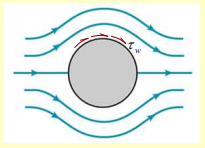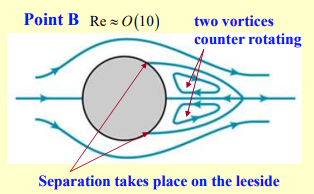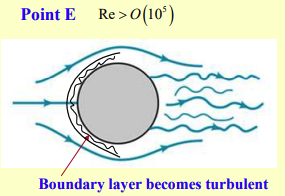The plot below shoes the drag coefficient on the -axis versus the Reynolds number on the -axis for smooth spheres (solid line) and smooth cylinders (dashed line).

Point A: Laminar/Creeping Flow
At this point, we have .

- Fluid moves smoothly around the sphere
- No separation or vortex formation
- Flow is viscous dominated, with inertial forces being negligible
The drag force is governed by Stokes Law:
Point B: Separation and Vortex Formation
Here, we have .

- Flow starts to separate at the rear of the sphere. Two counter-rotating vortices form, creating a low-pressure region.
- This introduces pressure drag in addition to shear drag; drag force is mainly due to the pressure difference
- Pressure inside the bubbles is very low
Point C: Oscillating Vortex Wake
In this region we have :

- A Kármán Vortex Street forms, characterized by alternating vortices shed behind the object. These vortices create an oscillating wake, introducing unsteady forces.
Point D: Turbulent Wake and Drag Crisis
Reynolds number: Approximately

- The separation point shifts backward and reach their limit position, reducing the size of the low-pressure wake.
- The flow inside the wake is turbulent
- Drag force is pressure dominated
- Flow physics remains the same
Point E: Fully Turbulent Boundary
Reynolds number: .

- The boundary layer is now completely turbulent.
- Separation points are pushed even further back, creating a narrower wake.
- Momentum transfer to the fluid is more effective.